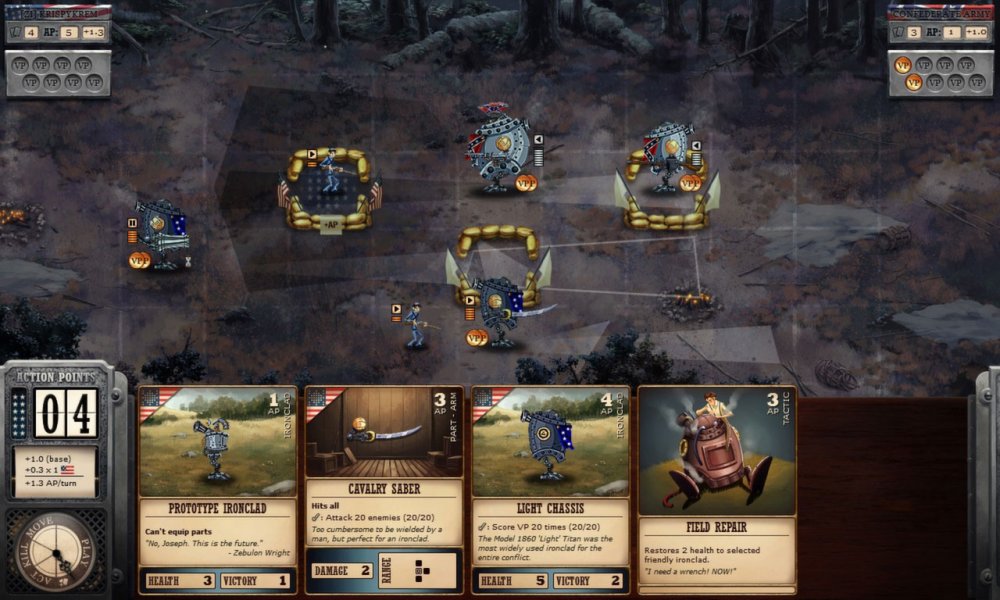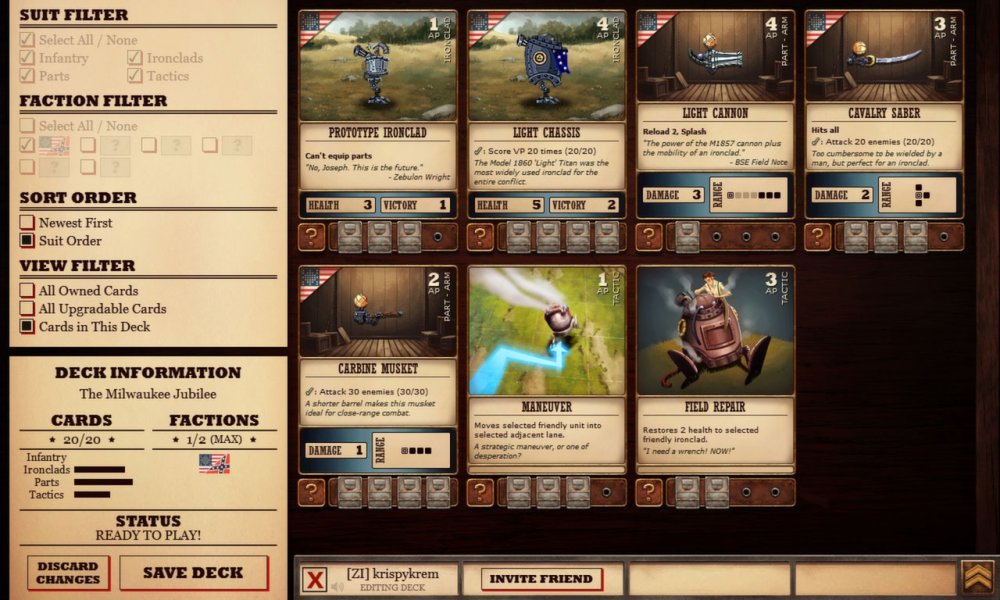

Ironclad Tactics comes from Zachtronics, the developer of the intensely cerebral SpaceChem. That fact might send a little shiver of fear across your cortex, but don't fret. Ironclad Tactics is easy to get into but still manages to provide a very deep experience once you spend some time with it.
The story unfolds as you journey across an alternate version of the continental U.S. during its Civil War. The big difference, as many historians will note, is there are steam-driven machines used in combat, not just dudes with Hulihee beards. The basic goal is to march your coin-carrying machines across the field, scoring a point for each coin and winning once you reach eight. Your opponent is trying to do the same, meaning you have to deploy units to battle theirs or risk staring at the wrong end of a game over screen.

Ironclad Tactics is all about the cards. The action takes place on a 9x4 grid with your units starting on the left and your opponents' on the right. Your deck unfolds one card at a time with a maximum of five cards in your hand. By spending action points (AP) you can place these cards on the field, summoning ironclads, calling in the infantry, equipping weapons and hats on certain machines, or initiating instantaneous tactical events. Each turn the units do their thing, stepping forward, firing their weapons, and if they're ironclads, squishing infantrymen like they're water balloons. The whole thing has the ambiance of a collectible card game with the tension of a turn-based strategy game, all rolling out at a sometimes frightening speed.
Ironclad Tactics is technically turn-based, but those turns are on a strict timer. You'll have a few moments to make your decisions and talk to your teammate, but it's not like you can go make a sandwich while pondering who should get the upgraded musket. Each round begins with the play phase, allowing you to pull cards out and use them on your units. After a few moments the action phase begins, setting in motion everything you just put out. Units then attack each other, followed by the destruction of any zero-health infantry or 'bots. Finally the move phase steps everyone forward and awards you with additional AP before it starts all over again.

Managing cards quickly becomes a vital part of the game. There are around 80 in all, each unlocked by completing story missions, winning while satisfying certain crazy conditions (protect the Jefferson statue? You have GOT to be kidding me!), or by completing the puzzle and skirmish rounds for each city. You're limited to 20 cards per deck, with a maximum of four of each card type per deck. Cards are divided into factions as well, and you can only have two factions per deck. One deck won't cut it for every stage, you'll need to have a few saved and ready for customization before each level begins. Be prepared to spend half as much time tinkering with cards as you will staring at machines on the battlefield.
The Ironclad Tactics set-up is really very elegant. The interface is a straightforward point and click affair, no keyboard shortcuts or other machinations are necessary. Unit types are easy to understand but offer tactical depth once their nuanced uses come into play. Even the single-use cards and weapons offer their share of strategical import. It may look useless on the surface, but that Movement card will save your mechanical butt more times than you can count, especially when you start dealing with stages that have key points to fight for and defend. Why oh why are human bones so crushable?
Co-op mode couldn't be more seamless. Joining with friends, you enter the main campaign and fight through city after city together. Players use their own decks, draw from their own pool of action points, and place cards simultaneously. Anybody can play cards on friendly units, but pausing a unit can only be done by that unit's owner. There can be the occasional moment of confusion when cards are placed on the same units simultaneously, but in general each player tends to stick to their own side of the overall strategy. Communication is extremely important, so Ironclad Tactics includes an in-game chat feature so you can sort out the details.
There are a few downsides to Ironclad Tactics, the most obvious of which is the use of cards and decks as its main mechanic. It's fantastic amounts of fun to craft and tweak different decks to handle different situations, and the faction/number limitations make formulating a deck strategy even more important. When carried into battles, though, you run the very real risk of getting a bad first hand. In Ironclad Tactics a bad first hand is often reason enough to reset the level, as you need every single advantage you can get. It's occasionally frustrating to have a victory hinge on the small matter of luck, but without randomness Ironclad Tactics just wouldn't be as exciting.
An item on the interface wishlist is slightly smaller card for the deck building screen. The sorting/filtering options work well enough, but with more cards on the screen you could make decisions without having to re-sort everything. A temporary "click to hide" option for cards that aren't filtered out but don't fit the theme of your deck would also be useful.
Ironclad Tactics does precisely what it sets out to do. It's more accessible than Zachtronics' previous offerings, but it doesn't lose too much complexity to achieve that. Co-op is fantastic and complements the game quite well. It relies a touch too much on luck than we're comfortable with, but otherwise it's a lengthy and satisfying game with all the tactical depth you could ever need.